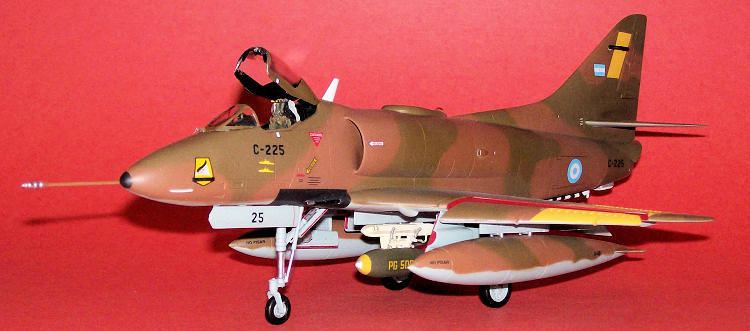
Hobbycraft 1/48 A-4B Skyhawk
| KIT #: | HC 1433 |
| PRICE: | CDN$25.00 MSRP |
| DECALS: | Four options |
| REVIEWER: | Pablo Calcaterra |
| NOTES: | Aerocalcas decals #48011 |

| HISTORY |
Skyhawk A4-B C-225
This particular Skyhawk was one
of the luckiest ones of the 1982 as it not only survived the war but also was
flown in combat missions by the leaders that led some of the most significant
actions of the
May 12th:
Attack to HMS Glasgow and HMS Brilliant that were shelling Puerto Argentino/Port
Stanley.
Two waves of 4 Skyhawks B
were to attack with a 15 minutes interval.
The first wave (OF
1177) was named CUÑA and was led by 1st Lt Bustos and his wingmen
were Lt. J. Ibarlucea, Lt. M. Nívoli and Ensg. A. Vázquez. They attacked with
the sea on their backs thus giving the Sea Wolf system of HMS Brilliant an
excellent chance
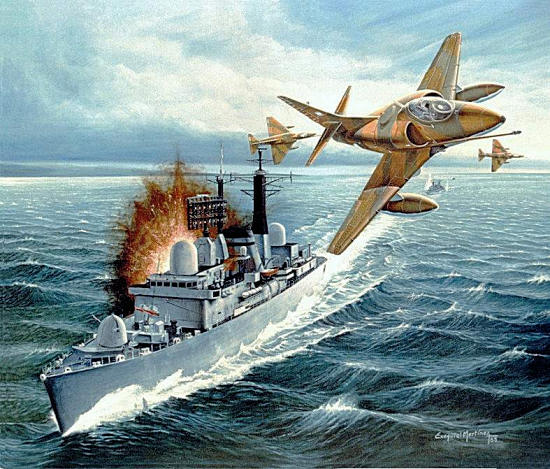 to
operate. Their windshields were covered with sea salt. Nívoli and Bustos were
shot down practically over the ships, while Bustos crashed on the sea while
calling his wingmen to join him. He had seen a 3rd Sea Wolf and
touched the sea while trying to evade it. The only survivor was Vázquez who
managed to drop his bomb and return to his base. They caused slight damage to
the deck of the ship. After the debrief, still affected by what he had gone
thru, Vázquez was asked what was he going to do next. After witnessing the death
of his 3 friends, his only answer was: “Get ready for the next mission”.
Everybody in the room was shocked and admired the resolution of this young Air
Force officer.
to
operate. Their windshields were covered with sea salt. Nívoli and Bustos were
shot down practically over the ships, while Bustos crashed on the sea while
calling his wingmen to join him. He had seen a 3rd Sea Wolf and
touched the sea while trying to evade it. The only survivor was Vázquez who
managed to drop his bomb and return to his base. They caused slight damage to
the deck of the ship. After the debrief, still affected by what he had gone
thru, Vázquez was asked what was he going to do next. After witnessing the death
of his 3 friends, his only answer was: “Get ready for the next mission”.
Everybody in the room was shocked and admired the resolution of this young Air
Force officer.
The following attack
was OF 1180 and their call sign was ORO. J. ORO: Capt. Antonio (Tony) Zelaya in
C-225, Lt. Arrarás in C-244, 1st Lt Gavazzi (C-248) and Alferez
Dellepiane in C-239.
The inbound flight took place without problem, except for the fact that Zelaya’s
navigational equipment broke and he was forced to navigate by compass and clock.
The attack time had also being pushed forward 15 minutes and they tried to
comply with it but they made it 7 minutes late (and 8 before the original
time!).
When they arrived to the Goose Green area, Zelaya realized that there had been a
drift in their direction and that they were now 4 miles to their right, when in
fact they should have been 7 miles to their left. Hence, he corrected their
heading.
On the radio, he was confirmed to proceed as originally planned. Nobody was
talking on the radio.
On both sides he could see his wingmen, Arrarás and Gavazzi, flying even lower.
Zelaya had to fly higher to check his maps and charts.
When the got to open sea, heading southeast, he descended even more. His idea
was to fly on that heading for 3 minutes and if nothing was found, return to
base.
The ships were not in the area where he was told they would be. He kept on
flying and shortly afterwards they saw the two ships leaving the area at full
speed after the attack of CUÑA. They were 20 NM to the south of the town.
Nothing was said to his wingmen, as instructions had been given before take off:
the leading section would attack the ship to the North, and the following one
the ships to the South.
No missile was fired at them but guns and machine guns were in action. Even the
noise of the AA could be heard over their jet engines.
As the planes were this time coming with the shore behind them, the Sea Wolf
system had trouble locking on them and no missile was fired at them.
The only one who made a mistake was Zelaya himself, as he attacked the ship that
was closer to him (the one on the South) so 3 ships attacked one and only 1 went
for the ship that was to the North (following the other ship).
At the moment when he had to drop his bomb, Zelaya could only see his gun sight
and the target. He still remembers the large radar antenna, turning. It was HMS
Glasgow.
After jumping his target, Zelaya found himself turning at a height of 300 mt,
trying to see what had happened to the ships. There was a great commotion in the
sea close to the leading ship, and ripples on the sea, as if something had
fallen there. Realizing that he was too high, he dove to the sea surface. All
the pilots were shouting excitedly but radio silence was kept except for Gavazzi
who said: “Long live the Homeland!”. Arrarás claimed that he had probably hit
his target while Gavazzi was sure he himself had
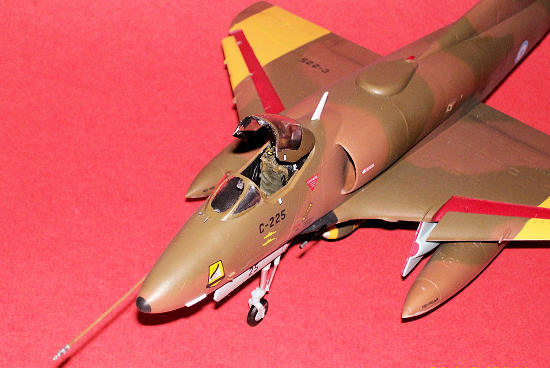 succeeded.
Though officially Gavazzi is credited with the hit, recently Zelaya said that he
believes that the pilot that hit
succeeded.
Though officially Gavazzi is credited with the hit, recently Zelaya said that he
believes that the pilot that hit
The fact that the ships had been further South made them fly away from their
original return route. Tony entered the islands at a 90 degree angle, in that
place the coast runs in an angle, so they started to fly NW instead of W.
They flew back split in two sections. Arrarás was forming with Zelaya, 90 mt
away. Gavazzi was leading Dellepiane some miles behind. They kept on flying low
as they had lost contact with the MLV radar and they did not know whether they
were being chased by Sea Harriers or not.
Now calmed down after the exciting attack, Zelaya checked his map and compass
and realized he was off course, with a different heading. He saw something
suspicious ahead of him, something shinning on the ground. He had a hunch and
decided to break left. Gavazzi, instead, kept on moving ahead.
Now they were all
silent and saddened. Dellepiane was forced to climb to save fuel but Gavazzi and
Arrarás kept flying low for 90 kilometers more.
Their windshields now covered with a layer of salt, their landing was a
difficult one. Vazquez plane landed ahead of them and accidentally left the
runway before stopping.
As
a result of their attack, HMS Glasgow received the hit of one of the 1,000 lb
bombs that did not explode, fell into the sea on the other side of the ship and
left two holes in the hull. Thru those, water was coming in. Engines and
electric systems were also affected by the attack. After some days, the ship now
unable to continue in the war theater due to the damage, returned to the
NOTE: of the 8 pilots
that took part in this mission, only 2 survived the war: Zelaya and Dellepiane.
Arrarás and Vázquez perished on the attack to the LCU Foxtrot on June 8th
at Bluff Cove/Bahia Agradable. This vessel was sunk in this attack.
May
21st:
C-225 was flown by 1st
Lt Mariano Velazco but had to return due to mechanical problems. The rest of the
planes (ORION) joined the LEOs and together they attacked HMS Argonaut, hitting
her with 2 bombs that left her out of service for the rest of the war.
May 25th:
Attack and sinking of HMS Coventry
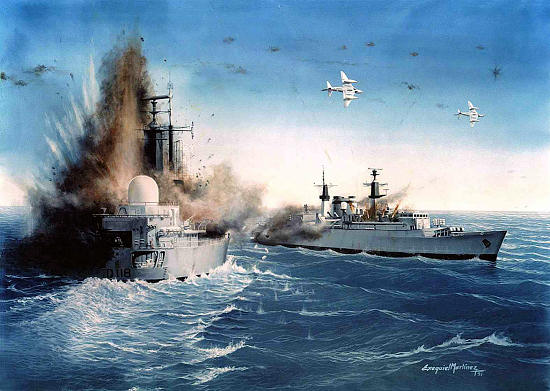 OF 1236
(VULCANO): C-225 was flown by the Capt. Pablo Carballo with Lt Rinke as his
wingman (Ensg Carmona was forced to return due to mechanical problems).
OF 1236
(VULCANO): C-225 was flown by the Capt. Pablo Carballo with Lt Rinke as his
wingman (Ensg Carmona was forced to return due to mechanical problems).
OF
1237 (
During the morning, a 42-22 combo located to the north of Borbon/Pebble Is. had
managed to shot down two Skyhawks with the Sea Darts from HMS Coventry (not 3 as
claimed by David Hart-Dyke in his book). It’s important to highlight the fact
that these planes were returning from their attacks to
Each section had their own route, so they were flying using different routes.
The now well-known
shape of the islands started to show on their windshields when a thin layer of
salt started to form on Carballo’s oval windshield. This had happened in
previous missions but had been solved by 1st Lt (biochemist) Haggi,
who found a solution to fix the problem.
He immediately remembered non commissioned officer Escobar, a mechanic who had
cleaned with all his love the windshield and who had asked Carballo if he was
satisfied with his job. He had cleaned away the solution! Pablo thought he might
have to return because it was difficult to look forward and also now his
gunsight was useless. Therefore he would have to calculate the point where to
drop his bombs and decided to keep on going.
They arrived to the first notification point, Puerto Ruiseñor, and contacted the
Rayo (tactical support aircraft), generally operated by Vicecomodoro “Duro
(Tough)” Pereyra and Major Medina. They would tell them if their target had
moved, where the enemy CAPs where…
Carballo soon discovered he was not going to be able to follow the initial
route, as he would not be able to fly above land from Puerto Ruiseñor onwards,
to
Skimming the water, as the only bumps are the waves, they flew towards the North
of Gran Malvina/West Falkland.To his left and slightly lower and behind, almost
touching the sea, was his “Iron-made wingman” as he called him, Lt Rinke.
Suddenly they were warned by Ranquel (Pereyra):
“Careful as there is Harrier
Carballo
acknowledged and understanding that he could get to my target before they could
be intercepted, he decided to continue.
This
Once the VULCANOs turned at the other extreme of the island, they turned East
and started to fly in the original direction. The nose of their planes started
to look for the place where the target should be. There they were, in the
horizon.
Pablo remembered a phrase that Pepe Biondi (a very famous Argentine comedian)
would always repeat during his performances: “I am so lucky to get into unlucky
situations…”
They were two dark dots, two impressive frigates against the horizon, covered in
mist, away from the coast, deep in the sea. Carballo thought: “This time, it
will be very tough as we will be exposed to their AA guns for a long time”.
They were a CL42 (HMS Coventry) and a CL22 (HMS Broadsword).
Carballo opened up all my engine, pressed the VHF button and said
“OK girls, I have them in sight, Long Live the Homeland! Maximum power! To the
one behind!” (The one to the West)
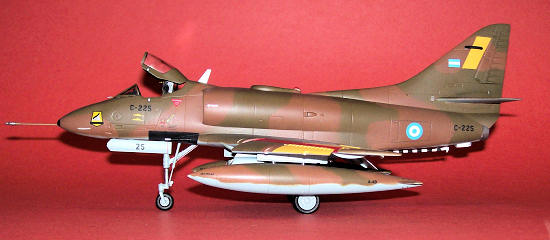 They started
the bomb run. Carballo felt very small when he started with my only wingman,
attacking those two huge steel constructions, that commenced their defensive
fire the moment the Skyhawks entered the sea flying from Rasa Is, even though
the planes were not in range. Their hits were at the beginning far ahead: water
was dancing and jumping high and there were explosion in the air that formed a
band that seemed to be alive. The ships were covered in smoke after each shot.
Carballo thought they were in the middle of a sea battles movie. The wall of
fire was very dense and both ships were firing with everything they had, and the
salt on the windshield prevented Carballo from seeing how close their hits
where. The windshield has 3 parts and he could only see thru the ones on the
sides as the oval one (center) was covered in salt.
They started
the bomb run. Carballo felt very small when he started with my only wingman,
attacking those two huge steel constructions, that commenced their defensive
fire the moment the Skyhawks entered the sea flying from Rasa Is, even though
the planes were not in range. Their hits were at the beginning far ahead: water
was dancing and jumping high and there were explosion in the air that formed a
band that seemed to be alive. The ships were covered in smoke after each shot.
Carballo thought they were in the middle of a sea battles movie. The wall of
fire was very dense and both ships were firing with everything they had, and the
salt on the windshield prevented Carballo from seeing how close their hits
where. The windshield has 3 parts and he could only see thru the ones on the
sides as the oval one (center) was covered in salt.
“Which one do we attack, sir?” asked Rinke.
“Let’s go to the one that’s behind, as it is less defended” Carballo answered.
Both ships started to accelerate, with high lips of water on their bows. They
were heading East with approx 200 mts of distance between them.
The Sea Wolf system
failed again, as it had happened on May 12th. This time, as the
planes were flying so close, the system could not decide what target to shoot at
first, so it turned itself off. It had to be reset manually, but the process
takes some seconds, vital seconds that they did not have.
C-225 was hit under the right wing by the defensive fire put by the ships but
Carballo kept on going. When the whole ship covered both sides of his blurred
windshield, he let his 1,000 lb bomb go, waiting a little more time than usual
due to his bad forward vision. He remembers that
“Did you pass, #2?”
He did not answer immediately but then Pablo got very happy when I heard Rinke
shout:
“Yes sir, I am here behind you and in sight!”
Almost at the same time, they heard another voice in the radio:
“I don’t see anything!”
It was 1st Lt Velasco who was arriving.
Pablo shouted:
“They are just North of the IP (Rasa Is)! Go on, go on!”
And Alferez Barrionuevo said:
“Ok, we have them to the left”
An explosion lifted a column of water close to C-225 when he was fired at while
escaping. Carballo said:
“I was hit, I think I was hit because I have felt several hits underneath” (I
had been hit by a small piece of shrapnel under his right wing).
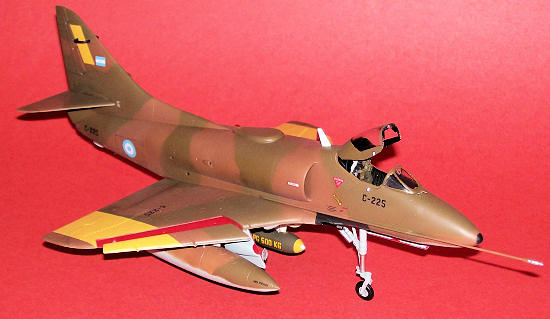 Broadsword
had stopped, with a hole his her hull, her landing deck and a hangar. The nose
of her Sea Linx was torn away by Carballo’s bomb (another unexploded one that
fell on the other side of the sea!).
Broadsword
had stopped, with a hole his her hull, her landing deck and a hangar. The nose
of her Sea Linx was torn away by Carballo’s bomb (another unexploded one that
fell on the other side of the sea!).
Velazco and Barrionuevo started their attack. Broadsword was pointing to the
East, while
The 800 Sqn pair started to track the second wave of Argentine planes, but again
they were called off by Broadsword.
As
the attention of their enemies was now focused on the
With an unbelievable agility, faster than what anybody can imagine,
“The missile, the missile!”
Then the ship put the side against the planes, as there is where it has more
armament, and started to shoot at the planes. The Sea Wolf system had clearly
acquired the targets. To prevent any mistake or mishap, the operator was
controlling the system manually and had one on the Skyhawks clearly in the
center of his screen. Ready to fire, the operator said: “You will die, b…!”. But
when
After dropping his bombs (Barrinuevos’ did not fall), Velazco asked the
standard:
“Have you passed, #2?”
“Yes sir, you hit it perfectly, it was a CL42, I saw her clearly, I almost
crashed against one of the domes, I saw your bombs hit the hull and in the other
one, close to the water line, there was a column of smoke!”
HMS Coventry had been hit by 3 bombs on her port side one meter above the
waterline. One failed to explode but nevertheless contributed to the posterior
flooding. The second one entered below the bridge and spiraled down from deck 2
to deck 4, below the computer room and exploded killing everyone there almost
immediately. The third bomb exploded as well, this time in the Forward Engine
Room and killed everyone in the dinning room, located above the FER. With fire
on board and taking water, the ship started to list and the damaged caused by
the bombs only helped the water to rise to the upper decks. Sadly, 19 members of
HMS Coventry lost their lives.
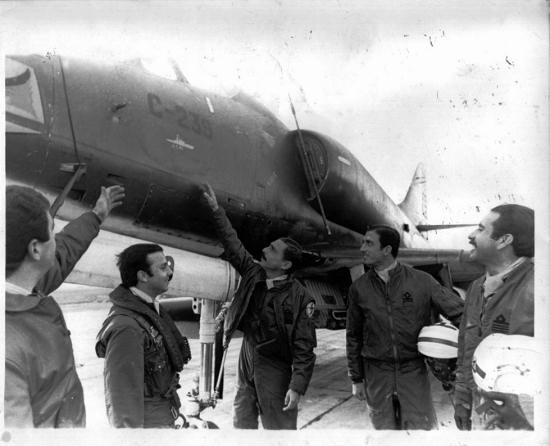 The 4 pilots
started to shout at the same time while they were still being fired at, but the
columns of water were quite behind. They shouted several “Long live our
Homeland!”, sapukays (traditional shouts from the
The 4 pilots
started to shout at the same time while they were still being fired at, but the
columns of water were quite behind. They shouted several “Long live our
Homeland!”, sapukays (traditional shouts from the
“Silence on the radio!”
After a practically quite trip back, except for Carballo’s concern about his
loss of fuel due to the slight damage to his plane (he even considered the
option of ejecting in case he run out of fuel), they made it back to their base.
Thomas and Smith returned to their carrier, “spitting nails”, completely angered
and frustrated as they could have prevented the catastrophe had they been given
permission to engage the incoming Skyhawks.
With the runway in sight, Carballo pressed the button on his radio and said:
“In our Homeland day, with the landing strip in sight!”
To their “eyes”, the radar operators, he said:
“We are all returning with the mission accomplished!”
“Tala” (Rinke) said:
“I never thought the sight of the airport would seem so beautiful to me!” and
asked Carballo:
“Sir, lets do a flypast over the base!” but he got rebuked:
“Are you nuts? We have survived the British and you want our own side to shoot
us down!?”
As soon as they landed,
the preliminary results of their attack were received. From the ground (Borbon/Pebble
Is) the Argentine garrison was able to see that 2 minutes after the Skyhawks
left the area, 4 Harriers arrived and flew over the ships. Shortly afterwards,
choppers from San Carlos arrived to rescue the sailors, as the ship attacked by
Mariano (HMS Coventry) sunk in approximately 20 minutes, while Broadsword limped
away very slowly, her helicopter destroyed and with a fire on board that was
controlled shortly afterwards.
The place thru which, as tradition says, the Skyhawks crossed Borbon/Pebble Is on their way to their target (in Pebble/Borbon) has now been called “Skyhawk gap”.
| THE KIT |
This kit was made
in
| CONSTRUCTION |
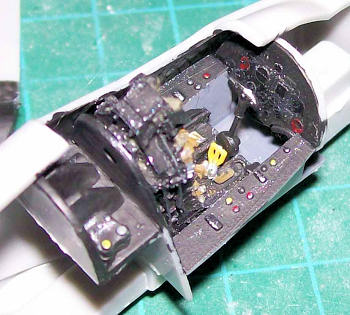 The cockpit
is fine. I painted the padded sides in green and details to the instrument
panel, with drops of Future on the little round glasses. The seat is a resin
one, much better than the one supplied with the kit, and it’s from Pavla models
(48008).
The cockpit
is fine. I painted the padded sides in green and details to the instrument
panel, with drops of Future on the little round glasses. The seat is a resin
one, much better than the one supplied with the kit, and it’s from Pavla models
(48008).
To correct
the nose, I took the two
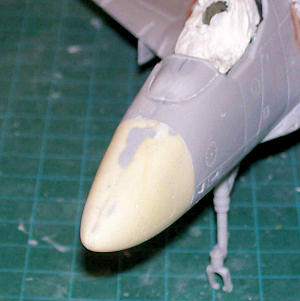 halves of
the Hasegawa kit, made a rubber mold and copied them in resin. They were not
perfect due to my impatience and the two halves did not fit as good as they
should, so I spent some time fixing the union of the halves with sandpaper,
putty and re scribing some panels again.
halves of
the Hasegawa kit, made a rubber mold and copied them in resin. They were not
perfect due to my impatience and the two halves did not fit as good as they
should, so I spent some time fixing the union of the halves with sandpaper,
putty and re scribing some panels again.
The internal
walls of the air intakes were painted in the cammo colors as they are difficult
to access with the airbrush, and then wet tissue paper covered them.
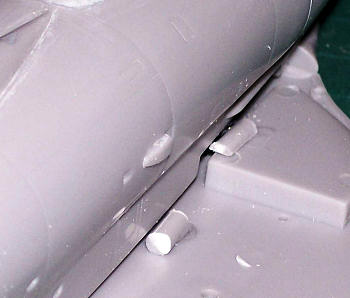 The main
parts (fuselage, wings) were put together. Some pieces of the tree were glued
under the union wings/fuselage to make a firmer contact zone that would resist
better sanding if required.
The main
parts (fuselage, wings) were put together. Some pieces of the tree were glued
under the union wings/fuselage to make a firmer contact zone that would resist
better sanding if required.
Then I moved
to the radome. The front of the part supplied with the kit is OK, but the area
around the red light is not. I had scratch built one several years ago, made a
rubber molde and now I used it ag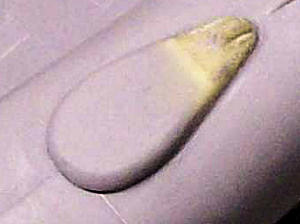 ain
to cast a resin part. More putty and sanding to flush the union…There is another
little radome under the fuselage, in the tail area. This is for an antenna. I
made it in resin too.
ain
to cast a resin part. More putty and sanding to flush the union…There is another
little radome under the fuselage, in the tail area. This is for an antenna. I
made it in resin too.
I used
acrylic base (water soluble) to hide some of the unions, improve the fit of the
parts. The advantage is that you don’t need sandpaper, and just before the base
gets dry, you can remove the excess with a soft damped cloth. A couple of
repetitions may be needed as some tiny holes may develop, but it’s much better
than using sandpaper. This only works for SMALL gaps.
I put together the external wing tanks (very good ones) and added the stations (3) and landing gear under the plane.
| COLORS AND MARKINGS |
First I
painted the undersides with Acryl RLM65. Once masked, I painted the upper
surfaces in Acryl 4707 and 4720. The interior of the flaps I painted in red and
the whole k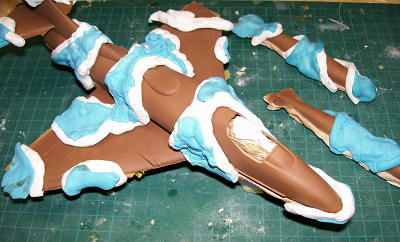 it
was masked to paint in yellow the ID bands. Interesting details is that most
publications show that the bands go all the way to the tip of the wings, but
recently found pictures in Internet show that they only go up to the end of the
slats (crashed Skyhawks found in the islands).
it
was masked to paint in yellow the ID bands. Interesting details is that most
publications show that the bands go all the way to the tip of the wings, but
recently found pictures in Internet show that they only go up to the end of the
slats (crashed Skyhawks found in the islands).
I gave the
kit a good coat of Future and applied the decals. The most challenging part was
to create the “5” for the numbers of the plane. HC and Aerocalcas don’t have
this number among their sheets. So I took the “9”s from the HC sheet (left from
a previous build, so quality of the number is much better) and cut the round
part in a way to form the bottom part of the “5”s and using some straight parts
from other numbers for the top part of the “5”s. This, I had to repeat 8 times!
I added two ships from the Aztec set of decals, roundels and flags along with
other stencils.
Finally, a coat of semi gloss coat to seal the decals, attached all the rest of
the parts (refueling probe, slats, lights, wheels, arresting hook, VHF and Omega
antenna, including a correct 1,000 bomb sent by Fab Nevarez which has a decal
from the Aerocalcas set) and scratchuilt the little pipes on the nose, gunsight,
rear mirrors inside the canopy and top ejection handle.
| CONCLUSIONS |
I felt very
happy with the results. The nose is not standing as high as it probably should,
but overall I believe it is an extremely accurate depiction of this famous
fighter bomber.
| REFERENCES |
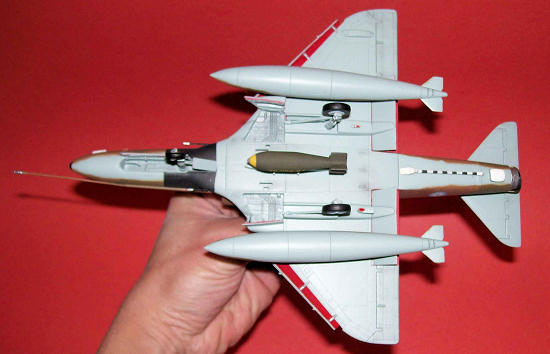 Halcones de
Malvinas, Pablo Carballo
Halcones de
Malvinas, Pablo Carballo
Hostile
Skies, Dave Morgan
Dios y los Halcones, Pablo
Carballo
Historia Oficial de la
Fuerza Aerea Argentina, volume VI
Emails with Allan White,
Tony Zelaya, David Smith and Pablo Carballo.
Official
Argentine Air Force website.
Four Weeks in May, David Hart Dyke
May 2009
If you would like your product reviewed fairly and quickly, please contact me or see other details in the Note to Contributors.